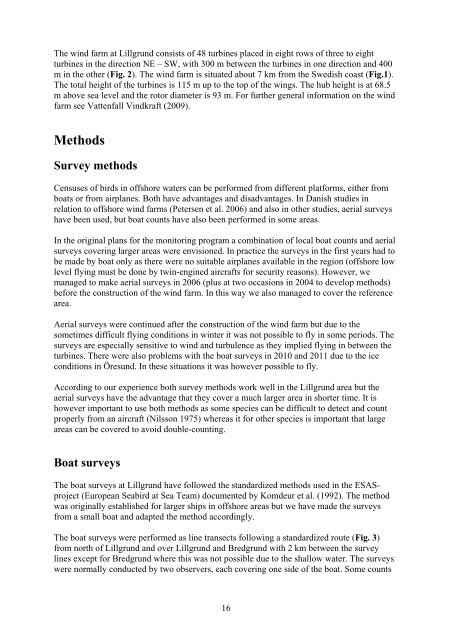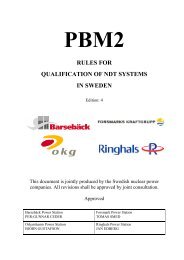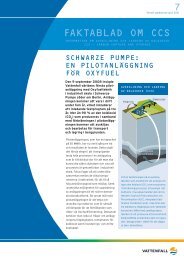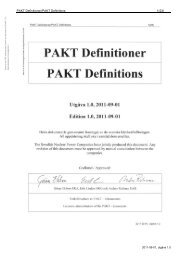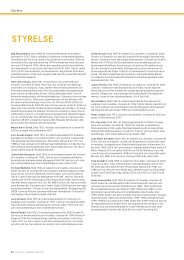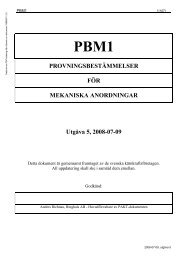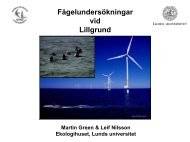Birds in southern Öresund in relation to the wind farm at ... - Vattenfall
Birds in southern Öresund in relation to the wind farm at ... - Vattenfall
Birds in southern Öresund in relation to the wind farm at ... - Vattenfall
You also want an ePaper? Increase the reach of your titles
YUMPU automatically turns print PDFs into web optimized ePapers that Google loves.
The w<strong>in</strong>d <strong>farm</strong> <strong>at</strong> Lillgrund consists of 48 turb<strong>in</strong>es placed <strong>in</strong> eight rows of three <strong>to</strong> eight<br />
turb<strong>in</strong>es <strong>in</strong> <strong>the</strong> direction NE – SW, with 300 m between <strong>the</strong> turb<strong>in</strong>es <strong>in</strong> one direction and 400<br />
m <strong>in</strong> <strong>the</strong> o<strong>the</strong>r (Fig. 2). The w<strong>in</strong>d <strong>farm</strong> is situ<strong>at</strong>ed about 7 km from <strong>the</strong> Swedish coast (Fig.1).<br />
The <strong>to</strong>tal height of <strong>the</strong> turb<strong>in</strong>es is 115 m up <strong>to</strong> <strong>the</strong> <strong>to</strong>p of <strong>the</strong> w<strong>in</strong>gs. The hub height is <strong>at</strong> 68.5<br />
m above sea level and <strong>the</strong> ro<strong>to</strong>r diameter is 93 m. For fur<strong>the</strong>r general <strong>in</strong>form<strong>at</strong>ion on <strong>the</strong> w<strong>in</strong>d<br />
<strong>farm</strong> see V<strong>at</strong>tenfall V<strong>in</strong>dkraft (2009).<br />
Methods<br />
Survey methods<br />
Censuses of birds <strong>in</strong> offshore w<strong>at</strong>ers can be performed from different pl<strong>at</strong>forms, ei<strong>the</strong>r from<br />
bo<strong>at</strong>s or from airplanes. Both have advantages and disadvantages. In Danish studies <strong>in</strong><br />
<strong>rel<strong>at</strong>ion</strong> <strong>to</strong> offshore w<strong>in</strong>d <strong>farm</strong>s (Petersen et al. 2006) and also <strong>in</strong> o<strong>the</strong>r studies, aerial surveys<br />
have been used, but bo<strong>at</strong> counts have also been performed <strong>in</strong> some areas.<br />
In <strong>the</strong> orig<strong>in</strong>al plans for <strong>the</strong> moni<strong>to</strong>r<strong>in</strong>g program a comb<strong>in</strong><strong>at</strong>ion of local bo<strong>at</strong> counts and aerial<br />
surveys cover<strong>in</strong>g larger areas were envisioned. In practice <strong>the</strong> surveys <strong>in</strong> <strong>the</strong> first years had <strong>to</strong><br />
be made by bo<strong>at</strong> only as <strong>the</strong>re were no suitable airplanes available <strong>in</strong> <strong>the</strong> region (offshore low<br />
level fly<strong>in</strong>g must be done by tw<strong>in</strong>-eng<strong>in</strong>ed aircrafts for security reasons). However, we<br />
managed <strong>to</strong> make aerial surveys <strong>in</strong> 2006 (plus <strong>at</strong> two occasions <strong>in</strong> 2004 <strong>to</strong> develop methods)<br />
before <strong>the</strong> construction of <strong>the</strong> w<strong>in</strong>d <strong>farm</strong>. In this way we also managed <strong>to</strong> cover <strong>the</strong> reference<br />
area.<br />
Aerial surveys were cont<strong>in</strong>ued after <strong>the</strong> construction of <strong>the</strong> w<strong>in</strong>d <strong>farm</strong> but due <strong>to</strong> <strong>the</strong><br />
sometimes difficult fly<strong>in</strong>g conditions <strong>in</strong> w<strong>in</strong>ter it was not possible <strong>to</strong> fly <strong>in</strong> some periods. The<br />
surveys are especially sensitive <strong>to</strong> w<strong>in</strong>d and turbulence as <strong>the</strong>y implied fly<strong>in</strong>g <strong>in</strong> between <strong>the</strong><br />
turb<strong>in</strong>es. There were also problems with <strong>the</strong> bo<strong>at</strong> surveys <strong>in</strong> 2010 and 2011 due <strong>to</strong> <strong>the</strong> ice<br />
conditions <strong>in</strong> <strong>Öresund</strong>. In <strong>the</strong>se situ<strong>at</strong>ions it was however possible <strong>to</strong> fly.<br />
Accord<strong>in</strong>g <strong>to</strong> our experience both survey methods work well <strong>in</strong> <strong>the</strong> Lillgrund area but <strong>the</strong><br />
aerial surveys have <strong>the</strong> advantage th<strong>at</strong> <strong>the</strong>y cover a much larger area <strong>in</strong> shorter time. It is<br />
however important <strong>to</strong> use both methods as some species can be difficult <strong>to</strong> detect and count<br />
properly from an aircraft (Nilsson 1975) whereas it for o<strong>the</strong>r species is important th<strong>at</strong> large<br />
areas can be covered <strong>to</strong> avoid double-count<strong>in</strong>g.<br />
Bo<strong>at</strong> surveys<br />
The bo<strong>at</strong> surveys <strong>at</strong> Lillgrund have followed <strong>the</strong> standardized methods used <strong>in</strong> <strong>the</strong> ESASproject<br />
(European Seabird <strong>at</strong> Sea Team) documented by Komdeur et al. (1992). The method<br />
was orig<strong>in</strong>ally established for larger ships <strong>in</strong> offshore areas but we have made <strong>the</strong> surveys<br />
from a small bo<strong>at</strong> and adapted <strong>the</strong> method accord<strong>in</strong>gly.<br />
The bo<strong>at</strong> surveys were performed as l<strong>in</strong>e transects follow<strong>in</strong>g a standardized route (Fig. 3)<br />
from north of Lillgrund and over Lillgrund and Bredgrund with 2 km between <strong>the</strong> survey<br />
l<strong>in</strong>es except for Bredgrund where this was not possible due <strong>to</strong> <strong>the</strong> shallow w<strong>at</strong>er. The surveys<br />
were normally conducted by two observers, each cover<strong>in</strong>g one side of <strong>the</strong> bo<strong>at</strong>. Some counts<br />
16


